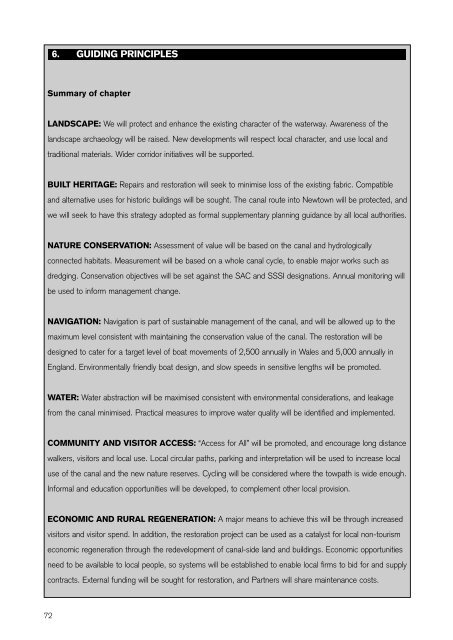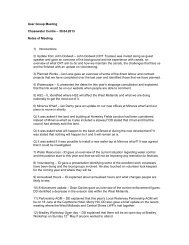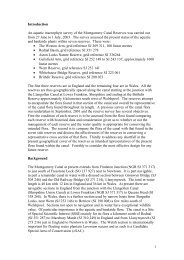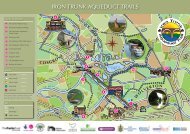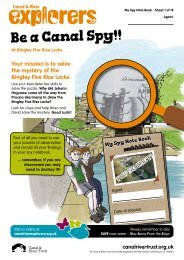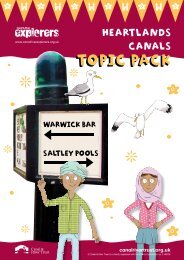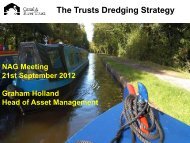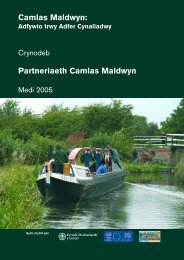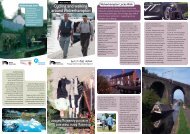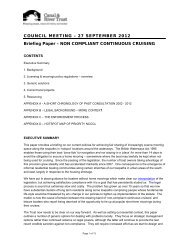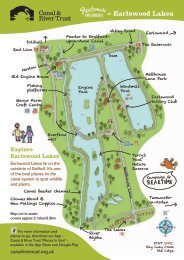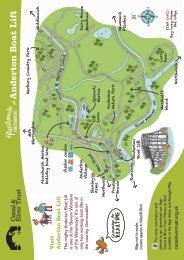Montgomery Canal Conservation Management Strategy (1.2MB PDF)
Montgomery Canal Conservation Management Strategy (1.2MB PDF)
Montgomery Canal Conservation Management Strategy (1.2MB PDF)
Create successful ePaper yourself
Turn your PDF publications into a flip-book with our unique Google optimized e-Paper software.
6. GUIDING PRINCIPLES<br />
Summary of chapter<br />
LANDSCAPE: We will protect and enhance the existing character of the waterway. Awareness of the<br />
landscape archaeology will be raised. New developments will respect local character, and use local and<br />
traditional materials. Wider corridor initiatives will be supported.<br />
BUILT HERITAGE: Repairs and restoration will seek to minimise loss of the existing fabric. Compatible<br />
and alternative uses for historic buildings will be sought. The canal route into Newtown will be protected, and<br />
we will seek to have this strategy adopted as formal supplementary planning guidance by all local authorities.<br />
NATURE CONSERVATION: Assessment of value will be based on the canal and hydrologically<br />
connected habitats. Measurement will be based on a whole canal cycle, to enable major works such as<br />
dredging. <strong>Conservation</strong> objectives will be set against the SAC and SSSI designations. Annual monitoring will<br />
be used to inform management change.<br />
NAVIGATION: Navigation is part of sustainable management of the canal, and will be allowed up to the<br />
maximum level consistent with maintaining the conservation value of the canal. The restoration will be<br />
designed to cater for a target level of boat movements of 2,500 annually in Wales and 5,000 annually in<br />
England. Environmentally friendly boat design, and slow speeds in sensitive lengths will be promoted.<br />
WATER: Water abstraction will be maximised consistent with environmental considerations, and leakage<br />
from the canal minimised. Practical measures to improve water quality will be identified and implemented.<br />
COMMUNITY AND VISITOR ACCESS: “Access for All” will be promoted, and encourage long distance<br />
walkers, visitors and local use. Local circular paths, parking and interpretation will be used to increase local<br />
use of the canal and the new nature reserves. Cycling will be considered where the towpath is wide enough.<br />
Informal and education opportunities will be developed, to complement other local provision.<br />
ECONOMIC AND RURAL REGENERATION: A major means to achieve this will be through increased<br />
visitors and visitor spend. In addition, the restoration project can be used as a catalyst for local non-tourism<br />
economic regeneration through the redevelopment of canal-side land and buildings. Economic opportunities<br />
need to be available to local people, so systems will be established to enable local firms to bid for and supply<br />
contracts. External funding will be sought for restoration, and Partners will share maintenance costs.<br />
72


